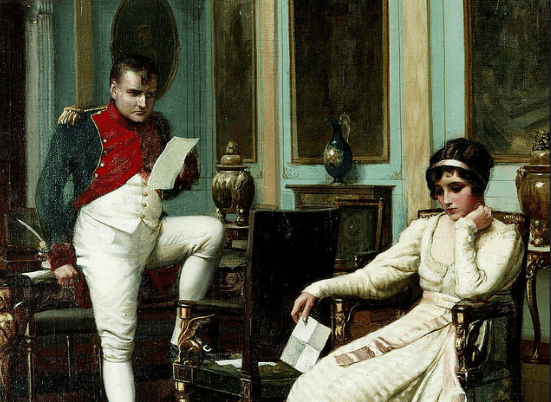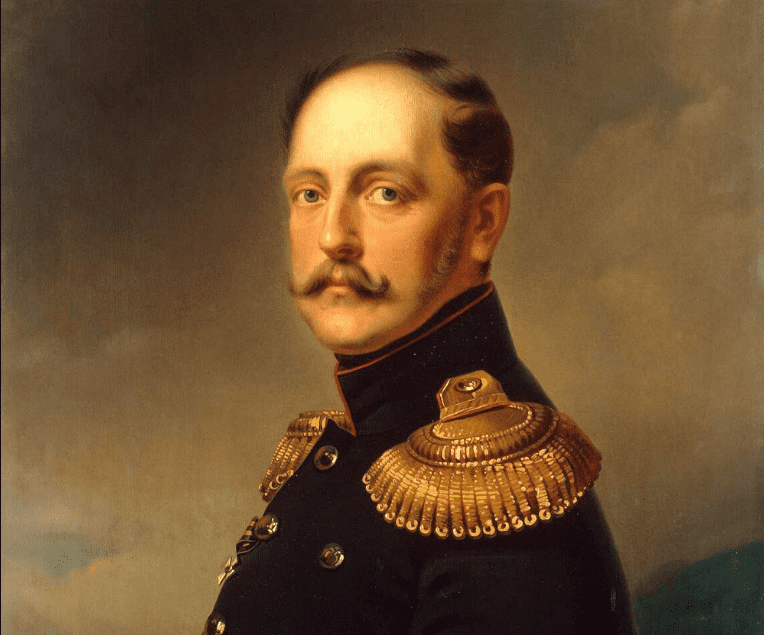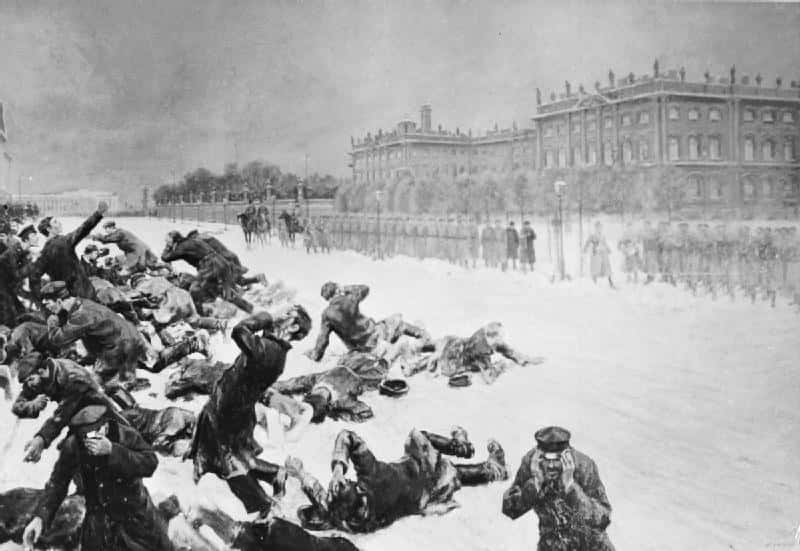The Winter Palace at Saint Petersburg, Russia is truly a house of many faces. On one hand, it is the symbol for Imperial tyranny. Built by Peter the Great and glorified by Catherine II, the historic Winter Palace came to inspire decadent art, but also, the class resentment that would change Russia forever. Into modern times, it has served as bureaucratic hub, hospital, museum, and even a bird cage. What makes this palace simultaneously so majestic, yet so terrifying and weird? Unfreeze these 42 chilling facts about the secrets of Russia’s Winter Palace.
Russia's Winter Palace Facts
42. Room to Dine and Dash
You could technically have a small town over for dinner at the Winter Palace. The dining room table seats 1,000 and the state rooms alone could hold 10,000, so long as they’re all standing.
41. Even Royalty Starts Somewhere
In the late 17th century, Peter the Great set up the city of Saint Petersburg as Russia’s new capital. Naturally, he needed a royal residence. The first royal house was a nothing but a simple log cabin. By 1711, however, Domenico Trezzini got to work on a larger residence for the Tsar that would be known as the first Winter Palace.
 Wikipedia
Wikipedia
40. Keeping Up with the Joneses Next Continent
As royal palaces became less of a target for warfare in the late 16th century, the princes of Europe could afford to have their homes a little less fortified and a little more stylish.
For the growing Winter Palace, this trend led to great flourishing changes in architecture that Peter the Great wanted to keep up with.
 Pixabay
Pixabay
39. Pack Up and Say “Non”
While the Louis XIV’s Palace of Versailles was the royal standard when it came to palaces, Peter never wanted to compete with the French king’s crib. I mean, who could?
38. Legally Required to Hang Out With Me
Not only did Peter the Great order all his nobles to build residences at his Winter Palace, but these aristocrats were also legally required to spend half the year there. However, it was no vacation. Saint Petersburg at the time was still an undeveloped “swamp” city that got little sunlight and barely anything grew there, save for cabbages and turnips. With this aesthetic, the Winter Palace was not initially popular with the posh class.
37. Not Worth the Cost
Although the cities around the Winter Palace were built very quickly, this was only possible by importing slave labor from around the Empire. All in all, about 200,000 workers’ lives were lost over the 20 years it took to settle on the land.
36. Welcome to the Jungle
Peter the Great died in 1725 without fulfilling his vision of the Winter Palace as the epicenter of European culture. Pretty much immediately after his death, the courtiers who were forced to be there fled the swamp city. In their wake, literal wolves and rebellious gangs of peasants swarmed the squares at night.
35. Relive Yourself In Style
We have Peter’s niece, Empress Anna of Russia, to thank for the Winter’s Palace’s more luxurious touches. Seeking to add a more “civilized” touch to the unpopular court, Anna had the ugly furniture relined with mahogany and ebony. She even had an “easing stool” (AKA, a toilet) made of silver and rubies.
34. Orange You Glad You Came?
Empress Anne of Russia’s first ball in the Winter palace involved a gallery that was made up to look exactly like an orange grove. How’s that for vitamin C?

History's most fascinating stories and darkest secrets, delivered to your inbox daily.
33. Your Loss is My Gain
Napoleon’s plunder was the Winter Palace’s pleasure. After the defeat of Napoleon in 1815, Tsar Alexander I purchased art from the ex-Empress of France, Josephine. In this exchange, the palace got another Rembrandt painting that was taken during her ex-husband’s many sieges.
32. Home Renovations from Hell
Elizabeth of Russia was determined to turn the once squalid Winter Palace into a testament of royal prestige. Even though Russia was struggling under the Seven Years’ War, Elizabeth still charged a tax of 859,555 rubles on state-owned taverns to fund her vanity project. When that wasn’t enough, the Empress simply taxed alcohol and salt for everybody. Laborers toiled for a monthly salary of one ruble a month.
31. My Home Improvements Will Live On
Altogether, Elizabeth of Russia’s renovations to the Winter Palace cost 2.5 million rubles. She didn’t even live to see it completed, dying in 1759 when it was just wrapping up production.
 Wikimedia Commons Konstantin Ukhtomsky
Wikimedia Commons Konstantin Ukhtomsky
30. It’s a Bird! It’s a Plane! It’s a Baby Tsar!
In 1762, Catherine II, or “Catherine the Great,” as she would come to be known, violently deposed her husband, Peter III. Claiming Russia for herself, she paraded her 7-year-old son, Paul, before the common people on the balcony of the Winter Palace. It’s here that the regime of Russia’s longest-reigning female ruler began.
29. The Best Philosophy is Avoiding It Altogether
Despite her tough image, the pressures of public life got to Catherine the Great. To escape, Catherine ordered a new wing of the palace to be made just for her and fittingly christened it “the Hermitage.” It’s said she got the idea from famous philosopher Jean Jacques Rousseau. We’re not sure if it was also his idea to add the heated courtyards, which housed exotic birds.
28. A Frame from Every country
When it came to royal art collections in the Winter Palace, Catherine II abided by a “more is better” policy… to the point of valuing quantity over quality. Catherine sent out ambassadors to Rome, France, and England to snag thousands of pieces for the galleries. A good use of diplomats’ time.
27. She’s Got to Catch ‘Em All
The Winter Palace once housed historic works such as Rembrandt’s “Portrait of a Scholar” and “Portrait of an Old Man in Red.” She even once obtained 225 portraits off an old enemy, Frederick the Great of Prussia, after he went to war with Russia and ran out of money to fund his own art addiction.
26. Make Way for the Aesthetic
Catherine the Great’s art addiction got so intense that she demolished Peter the Great’s historic (but dilapidated) third Winter palace to make way for an extension to her gallery, which she called the Hermitage Theatre.
25. Tied to the Job
Catherine the Great enslaved more than one million serfs in her reign. Many of them were used to complete the extravagant constrictions of her palace. The glory of the wintry interior didn’t line up with the lives of non-royal Russians who lived outside palace walls.
24. Stay Out of My Room, Mom
Catherine the Great’s son, Paul I, made additions to the Winter Palace to reflect his paranoia. The new Tsar had sentry boxes placed every few meters around the palace and upped the number of troops on guard. Did we mention he also hated any architectural mention of his mother?
23. In This End Is My Beginning
Unlike his mother Catherine II, Paul I hated the Winter Palace. It reminded him too much of mommy not-so-dearest. As a result, he removed himself from the court and built Saint Michael’s Castle atop his birthplace. Wishing to “die on the spot he was born,” he was promptly murdered there in 1801.
22. Measuring Contest
Nicholas I passed a law in 1884 to have all private houses at least 1 sazhen (or 2.13 m) shorter than the Winter Palace. Was he compensating for something?
21. Fire to Destroy All You’ve Done
On December 17, 1837, a great fire broke out in the Winter Palace that lasted for three whole days and was visible from 30 to 45 miles away. Although 30 guards died in the fire, almost no valuable objects (save for a few portraits) were permanently lost. Good news for Tsar Nicholas and his wife, bad for everyone else.
 Wikipedia
Wikipedia
20. Put Out With Care
During the 1837 Fire in the Winter Palace, the firefighting was slightly hindered by the material interests of the Empress. The Tsar Nicholas I ordered for the gallery to be dismantled so that the fire would stop spreading. The Empress’s privy councilor caught wind of this plan and tried to stop them, yelling, “Everything here belongs to the Empress! Not a thing must be broken!” How pretty were those paintings?
19. You Can Be Replaced
In the wake of the Great Fire, Tsar Nicholas I demanded the Winter Palace be completely rebuilt within a year. To complete this outrageous task, 6,000 men were employed to work, even in the dead of winter. As these men died, they were replaced with “other champions” who then died and started the process anew.
 GoodFreePhotos
GoodFreePhotos
18. Betrayed By the Dairy
There were so many rooms in the Winter Palace that an ex-servant and their family moved into the roof without anyone noticing. How were they discovered? By the smell of manure. The family had smuggled cows into the crawlspace, because what is slumming in the Winter Palace without your own supply of fresh milk?
17. Milk Maids
The maids of honor in the Winter Palace slept next to a room of cows. Again, these people just couldn’t do without a direct line to sweet, fresh milk. This bovine practice only ended with the great fire of 1837.
16. Boom Goes the Dynamite
Alexander II was the last Tsar to live full-time in the palace. Unfortunately, his being a hot target for repeated assassination attempts put a toll on the Winter Palace infrastructure. In 1880, there were plans to kill the Tsar as he dined by planting dynamite in the space underneath his dinner table. There were so many rooms, it was just taken for granted there would be space for bombs to go undetected.
Fortunately for Alexander, dinner was delayed for the first time in decades, so the bomb went off without him. The dining room exploded, killing 11 members of the Finnish Guard and wounding 30 others. What mattered, however, was that the tsar was unscathed.
 Max Pixel
Max Pixel
15. Cutting Corners Where It Doesn’t Count
After the assassination of Alexander II, his son, Alexander III, declared that the Winter Palace was just too huge to secure properly. The tsar started cutting the operating budget, which meant the end of daily table linen changes and no throwing away soap until it was all spent.
14. You’re Not Invited
The last big gala in the Russian Empire’s history took place in the Winter Palace, where Tsar Nicholas and his wife celebrated the reign of Alexei I with a costume ball. The royal couple dressed as Alexei and his Empress, decadently garbed in 17th-century clothes, and posed for their final known photograph together. The luxurious celebration inspired hostility and resentment from the starving Russian people outside…
13. Sunday Worst
The Winter Palace became the site of where the Russian Revolution began. In what became known as “Bloody Sunday” in 1905, a working-class leader named Father Gapon led a peaceful protest of 100,000 unarmed workers to the palace in hopes of presenting the Tsar with their petition.
Of course, by this point, the Winter Palace was no longer the royal residence of the Imperial family. Nevertheless, the tsar’s troops opened fire on the crowd, killing as many as 1,000 men, women, and children. This bloody blunder is considered a turning point in the end of the Russian Empire.
12. I Hate Medical Shows
During World War I, the Winter Palace served as an impromptu military hospital. What was once a small throne room to the most powerful Emperors of Russia became a mess room for the doctors.
11. We’re Moving in, Boys
In 1917, the Russian palace became a real site of power for the first time in a century. The Russian Provisional Government took seat in the palace…until the Bolsheviks rebelled. Cutting off all lines of contact from the palace to the outside world, the Bolsheviks seized the government via gunfire and destruction as the officials hid in private apartments once enjoyed by Russian royalty.
10. Now It’s a Party
During the Revolution of 1917, the Winter Palace’s wine and alcohol stores were left vulnerable to mobs. As one of the finest collections in the world, this was no ordinary liquor cabinet, and the Bolsheviks went to extremes to protect the drinks: a pipe was built to funnel the wine straight into the Neva. This wasn’t a perfect solution as crowds attacked the drains (they really wanted that liquor).
In the end, it took a declaration of martial law to keep away the thirsty mob. One person called it “perhaps the biggest hangover in history.”
9. Pay to See
The Winter Palace’s Hermitage Museum attracts about 3.5 million visitors a year, which makes it one of the most popular museums in the world.
8. Free Garbage Pick-Up
Peter III found a quick and easy way to clean debris from the Winter Palace. Issuing a decree that anyone could take anything from the square for free, all the trash was taken from the grounds within hours. One man’s trash is truly another much poorer man’s treasure.
7. It Ain’t Easy Being Green
Today, the Winter Palace is recognized for its distinct pale green hue. However, it’s only been this shade since 1946. Before that, it was a tickled pink color.
6. You Can’t Change the Past
When the Bolsheviks took power, they planned to remove all references to Imperial power from the palace’s design. Obviously, this was easier said than done. Ultimately, the remnants of old royal style in architecture were actually enhanced in the restoration project throughout the 1940s and ‘50s. So much for the revolutionary museum…
5. Is It Getting Hot Down Here?
It’s said Catherine the Great and her lover Grigory Potemkin “consummated” their affair in the basement saunas of the Winter Palace.
4. If I Could Watch a Thousand Miles
If you planned on looking at every painting in the Winter Palace’s Hermitage Museum for one minute, it would take you 11 years to complete the whole tour.
3. Show Me More
In 1920, the Bolsheviks re-enacted their historic takeover of the Winter Palace just three years earlier. Using hundreds of professional actors and dancers, the event was viewed by 100,000 spectators. It’s considered a momentous event in both political and theatre history.
2. Say “Oui” to Me
The Winter Palace can’t escape the shadow of Versailles. Not only did Catherine the Great model much of the palace’s architecture after the French baroque, but she also made it a policy that courtiers should speak French as the official court language.
1. Not Suitable for All Courtiers
The Winter Palace gained prominence in the reign of Elizabeth of Russia. As the daughter of its founder, Peter the Great, Elizabeth deposed the baby Tsar Ivan VI. When Ivan VI took the throne into his chubby fingers at the age of two months old, it didn't last long. His cousin Elizabeth overthrew him only a year later and then placed him in solitary confinement. He would remain in confinement for 20 years, where he had no contact and no windows, and eventually developed a mental illness. Later, Catherine the Great stepped in and gave him freedom...by having him murdered.
To make it clear that it was no longer preschool at the Russian court, Elizabeth turned the Winter Palace into her rather adult pleasure dome. In this age, the royal court became known as a site of “gilded squalor.”















































